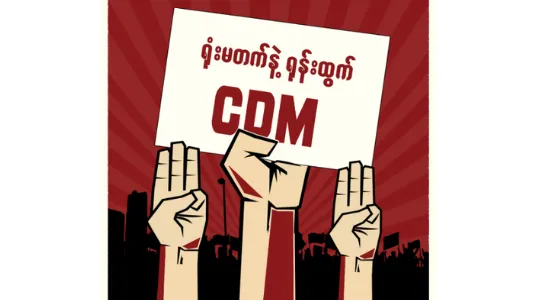Civil Disobedience Movement: A Foundation of Myanmar’s Spring Revolution and Force Behind Military’s Failed Coup
25 May 2023

Introduction
The Civil Disobedience Movement (CDM) is one of the key pillars of Myanmar’s Spring Revolution. It is an ongoing civil resistance movement that has evolved from the early days of the Spring Revolution when the Myanmar military attempted a coup d’état on 1 February 2021 and is one of the key reasons why the coup has failed. In its very initial form it could be defined as a mass strike, where public sector workers from the lower rungs of the civil service through to the very top, including health, education, banking employees, railway workers, oil and gas workers, engineers, lawyers and judges, civil servants and members of the security services refused to work for the junta and refused any other order from them. It quickly morphed into a nationwide movement in which private sector workers withdrew their labor, private businesses refused to cooperate with the junta, and consumers boycotted military-linked products and services. It is a classic civil resistance movement in the Ghandian tradition of non-violence. The objective of this withdrawal of labor is to deny the junta any legitimacy or ability to govern, sending a strong signal that the people of Myanmar will not accept a military dictatorship. Despite this withdrawal of labor under the junta, CDMers1 have continued to provide health, education and other essential services for Myanmar people under the auspices of the National Unity Government (NUG), Ethnic Revolutionary Organizations (EROs), or people’s administration teams. Furthermore, the CDM, like the broader Spring Revolution, is made up of a diverse and inclusive group of people from all regions and all walks of life.
This report argues that the CDM has evolved, from a reaction, or a withdrawal from and non-cooperation with the military, to a movement that is building a federal democracy through people power that is stronger, more diverse and inclusive than any previous people’s movements in Myanmar. Not only is it reacting and resisting the military, but it is creating a new nation in its place. This report will outline the evolution of the CDM and highlight some of the main threats and challenges that CDMers face, particularly related to security and livelihood pressures. CDMers are under immense pressure and some have felt the need to return to a work place under the junta’s control. They have made incredible sacrifices for their and their children’s lives for a free and fair democratic Myanmar. Some are in liberated areas of Myanmar, while some have become displaced, either internally or across Myanmar’s borders. There remain substantial needs, despite the efforts of the NUG – Myanmar’s legitimate government formed in the country based on the 2020 elections result – and the Committee Representing Pyidaungsu Hluttaw (CRPH) as well as ethnic nationality communities, civil society organizations (CSOs), celebrity fundraising, and the diaspora to support the CDM. And while there are other components of the Spring Revolution – namely the armed resistance manifested in the various People’s Defence Forces (PDFs), and the NUG itself – the CDM is a key, non-violent component that hinders the junta’s ability to function as a governing power. This report then, also argues that for international allies of Myanmar’s Spring Revolution to strengthen the movement for human rights, federal democracy, justice and accountability, CDMers must be recognized and supported as human rights defenders according to internationally-recognized definitions of Human Rights Defenders (HRDs).
The objective of this report is to provide a snapshot that summarizes the CDM from its inception in response to the attempted coup d’état launched by the Myanmar military on 1 February 2021 until the end of 2022. The report aims to examine the CDM as a key pillar of the revolutionary movement, including discussing the groundswell of support for a genuine federal democracy – one that is inclusive of all women, ethnic communities, religious communities, disabled and LGBTIQ+ people. The research methodology for this report was formulated based on a preliminary needs assessment, consulting with human rights defenders and CDMers in July and August 2022. As part of research for this report, 22 interviews with individuals or pairs of individuals, 13 female and 9 male, were conducted with CDMers and human rights defenders to provide a snapshot of the current situation of the CDM, their aspirations and on-going needs as the Spring Revolution has progressed over the past two years. These CDMers come from various civil service departments including health, education, railways, administration, military and the police, across different regions and states throughout Myanmar. The HRDs are members of civil society organizations working in Kachin, Karen, Karenni, Shan, Chin, Sagaing and Magwe States and Regions, who have been supporting the CDM since the Spring Revolution began. This information is accompanied by desk research, including information gathered from local civil society organizations and partner organizations, academic articles, NGO reports, and journalistic sources.
Announcements
21 May 2025
Open letter: Malaysia must lead ASEAN with principle, not hypocrisy, to address the Myanmar crisis

Progressive Voice is a participatory rights-based policy research and advocacy organization rooted in civil society, that maintains strong networks and relationships with grassroots organizations and community-based organizations throughout Myanmar. It acts as a bridge to the international community and international policymakers by amplifying voices from the ground, and advocating for a rights-based policy narrative.
